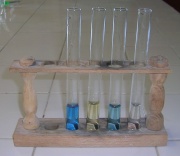Praktikum: Bau einer Panflöte aus Reagenzgläsern
Arbeitsauftrag
- Berechnen Sie die Längen der Luftsäulen für die Notenwerte einer Dur-Skala. (In reiner Stimmung und in gleichstufiger Stimmung)
- Bauen Sie eine gestimmte Panflöte aus den Reagenzgläsern.
- Material
- Reagenzgläser, Reagenzglasständer, Wasser
- Theoretischer Hintergrund
a) Die "reine Stimmung":
Bei dieser Stimmung sind alle Töne auch Obertöne des Grundtons. Dafür sind die Tonabstände nicht gleichmäßig. Es gibt einen großen und einen kleinen Ganztonschritt. Zwei Halbtonschritte sind auch kein Ganztonschritt.
| C-Dur | C | D | E | F | G | A | H | C | |||||||||
|---|---|---|---|---|---|---|---|---|---|---|---|---|---|---|---|---|---|
| Intervall | Prime | große Sekunde |
große Terz |
Quarte | Quinte | große Sexte |
große Septime |
Oktave | |||||||||
| Frequenz | [math]f_0[/math] | [math]\tfrac{9}{8}\, f_0[/math] | [math]\tfrac{5}{4}\, f_0[/math] | [math]\tfrac{4}{3}\, f_0[/math] | [math]\tfrac{3}{2}\, f_0[/math] | [math]\tfrac{5}{3}\, f_0[/math] | [math]\tfrac{15}{8}\, f_0[/math] | [math]2\, f_0[/math] | |||||||||
| Frequenzverhältnis benachbarter Töne |
[math] \begin{matrix} \longmapsto \\ \cdot \tfrac{9}{8}\end{matrix}[/math] | [math] \begin{matrix} \longmapsto \\ \cdot \tfrac{10}{9}\end{matrix}[/math] | [math] \begin{matrix} \longmapsto \\ \cdot \tfrac{16}{15}\end{matrix}[/math] | [math] \begin{matrix} \longmapsto \\ \cdot \tfrac{9}{8}\end{matrix}[/math] | [math] \begin{matrix} \longmapsto \\ \cdot \tfrac{10}{9}\end{matrix}[/math] | [math] \begin{matrix} \longmapsto \\ \cdot \tfrac{9}{8}\end{matrix}[/math] | [math] \begin{matrix} \longmapsto \\ \cdot \tfrac{16}{15}\end{matrix}[/math] | ||||||||||
b) Die "gleichstufige Stimmung":
Bei dieser Stimmung stimmen die Töne nicht mehr exakt mit den Obertönen des Grundtons überein. Daraus ergibt sich ein anderer Klang.
Die Oktave wird in 12 gleichgroße Halbtonschritte aufgeteilt. Damit sind alle Ganztonschritte gleich groß, nämlich gerade zwei Halbtonschritte.
Das Frequenzverhältnis vom Grundton zur Oktave ist 1:2, deshalb ist das Frequenzverhältnis eines Halbtonschrittes:
- [math] 1 \cdot h^{12} = 2 \quad \Rightarrow\quad h = \sqrt[12]{2} \approx 1{,}0595[/math]
| C-Dur | C | D | E | F | G | A | H | C | |||||||||
|---|---|---|---|---|---|---|---|---|---|---|---|---|---|---|---|---|---|
| Intervall | Prime | große Sekunde |
große Terz |
Quarte | Quinte | große Sexte |
große Septime |
Oktave | |||||||||
| Frequenz | [math]f_0[/math] | [math]h^2 \, f_0[/math] | [math]h^4\, f_0[/math] | [math]h^5\, f_0[/math] | [math]h^7\, f_0[/math] | [math]h^9\, f_0[/math] | [math]h^11\, f_0[/math] | [math]2\, f_0[/math] | |||||||||
| Frequenzverhältnis benachbarter Töne |
[math] \begin{matrix} \longmapsto \\ \cdot h^2\end{matrix}[/math] | [math] \begin{matrix} \longmapsto \\ \cdot h^2\end{matrix}[/math] | [math] \begin{matrix} \longmapsto \\ \cdot h\end{matrix}[/math] | [math] \begin{matrix} \longmapsto \\ \cdot h^2\end{matrix}[/math] | [math] \begin{matrix} \longmapsto \\ \cdot h^2\end{matrix}[/math] | [math] \begin{matrix} \longmapsto \\ \cdot h^2\end{matrix}[/math] | [math] \begin{matrix} \longmapsto \\ \cdot h\end{matrix}[/math] | ||||||||||
c) Eine Pentatonik
Verwendet man von den sieben Tönen der C-Dur-Skala nur die fünf Töne C, D, E, G und A, so klingen alle Töne miteineinander sehr harmonisch und man kann damit irgendetwas improvisieren, ohne dass es schräg klingt. Das geht am besten mit der reinen Stimmung.
- Beobachtungen
| C-Dur | C | D | E | F | G | A | H | C | |||||||||
|---|---|---|---|---|---|---|---|---|---|---|---|---|---|---|---|---|---|
| Intervall | Prime | große Sekunde |
große Terz |
Quarte | Quinte | große Sexte |
große Septime |
Oktave | |||||||||
| Luftsäule (cm) "rein" |
|||||||||||||||||
| Luftsäule (cm) "gleichstufig" |
